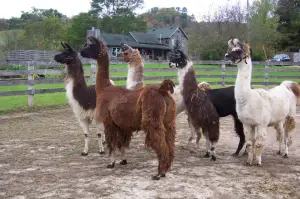Are Llamas Dangerous?
Between their size and their courage, llamas may seem intimidating at first. They can mature to be up to 6’ tall, can reach over 400 pounds, and they don’t back down easily. But what do we really know about the temperaments of llamas – are they a danger to us?
Are llamas dangerous? One of the benefits of having llamas is their temperaments – they are typically gentle, mild-mannered, and easy-going. The worst that most well-adjusted llamas will do is spit at you. If over-handled as a baby, however, (male) llamas can become aggressive toward humans.
Read on for more information on why llamas are appreciated over many other types of livestock for their personalities and what can happen if you pay too much attention to a very young llama.
Are Llamas Dangerous: The Temperament Of Llamas
The personality of most llamas is what makes them fabulous pack animals, livestock guardians, and, more recently, as therapy animals. Llamas are intelligent and inquisitive, making them easy to train and a pleasure to work with. And while each animal is an individual, llamas are generally known to be quite gentle, calm, and mild-mannered. This allows them to thrive in positions of therapy animals and petting zoo attractions.
Another benefit of the llama’s temperament is that they are not easily spooked. Llamas are known to be very easy-going and often “bomb-proof.” This is one of the advantages that llamas have over mules and donkeys as pack animals.
While donkeys are generally easy-going as well, llamas simply are not as easily spooked as their equine friends. This also serves them well in the role of livestock guardian. Llamas are popularly added to herds of smaller livestock as their protectors. They are very territorial and will not back down from a threat, both alerting and protecting the herd from danger.
Are Llamas Dangerous To Dogs?
A llama may see a dog as a threat, and care should be taken when introducing the two species – even if your dog is gentle and accustomed to being around livestock. Wild dogs, coyotes, and wolves are one of the biggest threats that llamas, alpacas, and other livestock face.
Llamas do not shy away from these threats, and they have even been known to kill coyotes – charging, kicking, and stomping on them if they make the poor decision to stick around llama territory too long.
This doesn’t mean that you can’t employ both a llama and a dog as guardians over your livestock. If you would like to keep a dog in the pasture, introduce them slowly and make sure to keep a close eye on them. Ideally, your dog will respect the llama’s space and will not get too close. Once the llama learns that your dog is not a threat, he should accept him in the pasture. They can serve doubly as livestock guardians, as dogs are often employed in this role as well.
Llama Aggression: Berserk Llama Syndrome 
Berserk Llama Syndrome (BLS) is a serious problem seen mostly in human-reared male llamas (and is, in fact, sometimes called Berserk Male Syndrome). If a cria (baby llama) is bottle-fed and raised by humans, there is a high chance of him “imprinting” on his human handlers, and will grow up accepting them as part of his herd.
Male llamas fight constantly to climb the social ladder within the herd, and if a llama inappropriately sees his human handlers as members of his herd, he will often attempt to dominate them through kicking, charging, chest-ramming, and neck-swinging. While this is generally not a concern between a pair of male llamas, it can be very dangerous when these aggressive actions from a 400-pound animal are directed at a human.
Unfortunately, there is usually no cure for BLS. When an animal in this condition begins exhibiting dangerous behaviors, he will typically be euthanized. To avoid this, it is important to avoid bottle-feeding a llama if at all possible. This may not always be feasible, as though female llamas make excellent mothers, there will occasionally be the rejection of a cria.
In this situation, it’s important to feed the llama with as little human interaction as possible. You can try feeding him through the fence instead of cuddling with him, and as soon as he’s done with the bottle, get up and leave. If your goal is to raise a friendly llama for a petting zoo operation, you should take care not to expose a cria to children too early. Make sure to create and maintain appropriate boundaries, especially during the adolescent period.
Do Llamas Bite?
Male llamas develop three sets of what are called “fighting teeth.” These teeth are very sharp, and the jaws are quite strong. While biting is not the preferred method of defense, there are several episodes documented of male llamas biting other males who they perceive to be threats to their herds. Not only will they bite the other male’s neck and flanks, but they will also target the rival’s testicles – in some cases, even castrating the other animal using nothing but their teeth.
While this sounds particularly violent, rest assured that llamas rarely bite humans. Their typical first line of defense against a human is usually the act of spitting (more on this below). Nevertheless, the simple fact that the possibility exists leads most llama breeders to remove immature fighting teeth at a very young age.
Fighting teeth in females usually are very underdeveloped, and if not removed as a cria, a gelded male will often have much smaller fighting teeth than an intact male.
Do Llamas Kick?
Being on the receiving end of a kick from a large animal can be very dangerous – the most obvious example of this would be the powerful kick of a horse. But llamas aren’t horses, and they rarely resort to kicking either humans or one another. There are a couple of considerations when it comes to llamas and kicking, however.
The first is that they have toenails and not hooves. Their toes are split into two strong, sharp toenails – these can add to the pain of being kicked by a powerful animal. The other consideration is that llamas, unlike horses, can kick from the side and also in a forward motion. This is unlike the horse, which primarily kicks from the rear. If you are used to horses, then you will need to remind yourself when working with a squirrely llama that you are not immune from getting kicked if you are standing at his side (or in front of him).
Do Llamas Spit?
If llamas rarely bite and rarely kick, then how do they express displeasure with one another? If you know anything about llamas, you likely have the answer to this – by spitting.
Spitting is a tool of communication that llamas use frequently, especially against one another. They can use spitting as a method of warning one another to stop a particular behavior, creating physical boundaries, displaying dominance, or as an attempt to climb the social ladder.
Llamas have two different types of spit at their disposal. If they are annoyed or wish to express displeasure, they may issue just a “dry spit.” This will be a mixture of air and saliva – similar to the spit that a human would produce. This kind of spit is meant as a warning – if you don’t back off, you may find yourself suffering a “real” spit.
Real llama spit – the kind that most people imagine (and dread) when they think of a spitting llama – can actually be better described as vomit. This spit will be green in color because it will be actual regurgitation from the llama’s stomach. While this type of spit is not going to harm you, no one enjoys being vomited on.
Fortunately, most well-trained llamas do not spit as often as one might think. In fact, when a human is on the receiving end of a real spit, it is often due to being in the wrong place at the wrong time – llamas may not spit at humans very often, but they will occasionally spit at one another over power struggles or dinner disagreements, and if a human gets caught in the middle things can take an unfortunate turn.
If you spend enough time with llamas, you will begin to learn their language and will be able to avoid being spit on because you’ll notice the signs before things escalate.
Llamas Are Generally Gentle, Not Aggressive 
Llamas are animals, and any animal can be dangerous under certain circumstances – especially one that is roughly twice the size of an adult human. Llamas are not aggressive, though, but rather quite the opposite. They are gentle, mild-mannered, easy to get along with, and generally go with the flow.
They are easy-going and flexible. They’re also very intelligent and trainable. So long as you adopt appropriate boundaries with a llama from the start and you guarantee that you maintain those boundaries, you should end up with a relaxed, respectful llama.

